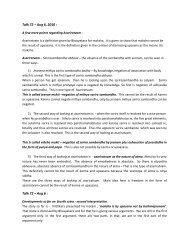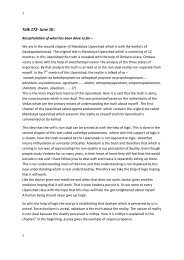Talk 119 Nov 14, 2010.pdf - arsha vidya kendra trust bangalore
Talk 119 Nov 14, 2010.pdf - arsha vidya kendra trust bangalore
Talk 119 Nov 14, 2010.pdf - arsha vidya kendra trust bangalore
Create successful ePaper yourself
Turn your PDF publications into a flip-book with our unique Google optimized e-Paper software.
<strong>Talk</strong> <strong>119</strong> –<strong>Nov</strong> <strong>14</strong>, 2010:<br />
Summary of the first Chapter –<br />
Mandukya Upanishad - Agama prakaranam :<br />
There are 4 chapters which are forming the complete commentary on Mandukya<br />
Upanishad which is a very small but profound Upanishad. It has been said –<br />
<br />
<br />
<br />
<br />
<br />
mANDUkyam ekameva alam mumukShUNAm vimuktaye.<br />
The Mandukya alone is enough for a mumukShu to get freedom.<br />
This Mandukya Upanishad is commented upon by Gaudapadacharyaji who is the grand guru<br />
of Shankaracarayaji. Gaudapadacharyaji has written the commentary in verse form called<br />
karika. This karika is concentrating on the mantras of the Upanishad in the first chapter.<br />
Afterwards one or two words of the Upanishad will be elaborated. But the first chapter is<br />
mainly concentrating on the mantras themselves. That is why it is called Agama<br />
prakaranam. Agama means Veda which here refers to Upanishad. Prakarana means<br />
chapter. Since Upanishad is the main portion of this chapter, hence it is called Agama<br />
prakaranam.<br />
Structure of Agama prakarana –<br />
This upanishad has 12 mantras which are commented upon by 29 karikas . There are some<br />
Upanishad mantras, then some commentaries, then Upanishad mantras and again some<br />
commentaries. This is the structure of Agama prakarana.<br />
In the Upanishad there are mainly two topics. Each topics has six mantras.<br />
1) Atma vicara - analysis of the nature of the self. Atma vicara is presented from mantras 2<br />
to 7.<br />
2) Omkara vicara – analysis of the word ‘Om’. Omkara vicara is presented in<br />
mantra 1 and mantra 8 to 12.<br />
This is the broad layout of the Upanishad. In between there are commentaries.<br />
From 1 to 6th mantras, there are no karikas. After that, there are 9 karikas – karika 1 to 9,<br />
which comment upon these six mantras.<br />
Then comes 7th mantra and after that there are 9 karikas – karika 10 to 18 which comment<br />
upon the 7th mantra.<br />
Then comes 8 to 11th mantra which is commented upon by 5 karikas – karika 19 to 23.<br />
Finally the 12th mantra which is commented upon by 6 karikas – karika 24 to 29.<br />
This is the layout of Agama prakarana : Mantra- commentary - mantra- commentary.
Content of the chapter –<br />
The main two topics talked about here is – Atma vicara and Omkara vicara.<br />
1) The first topic discussed is Atma vicara –<br />
First in atma vicara it is said– - sarvam hi etad brahma - Everything is Brahma.<br />
Then it is said – - ayam atma brahma - Atma, the self is Brahman, the limitless<br />
reality .<br />
A question may be asked – How can I be Brahman? To answer that question atma is<br />
introduced as catuspat – the one having four aspects or padas – Vaisvanarah, Taijasah,<br />
Prajnah and fourth is called Turiyam. From the 3 rd mantra to the 6 th mantra the three padas<br />
of atma are talked about. Aspect of atma means atma the consciousness with a particular<br />
adjunct or upadhi. Here the upadhi is a particular avastha.<br />
In the 3 rd mantra, the first pada of atma called Vaisvanarah is presented. I, the conciousness<br />
with the jagrat ie, waking state as upadhi or sthula prapanca is Vaisvanarah. This<br />
Vaisvanarah is described as saptangah (with seven limbs), sthula bhuk (enjoyer of gross<br />
things), ekonavimshati mukhah(with 19 mouths).<br />
In the 4 th mantra, the second quarter of atma called Taijasah is presented. I, the<br />
conciousness conditioned with svapna ie, dream state as upadhi or sukshma prapanca is<br />
Taijasah. At the vyashti (indvl.) level , I am called Taijasah and at the samashti (total) level I<br />
am called Hiranyagarbah.<br />
In the 5 th and 6 th mantra, the third quarter of atma called Prajnah which is non-separate from<br />
Isvara is described. These four mantras talked about the 3 aspects of atma.<br />
Note : In this Upanishad the micro and macro are taken as one only. In the first pada Visva<br />
and Vaisvanarah are taken as one. Taijasha and Hiranyagarbha are one in second pada<br />
and Prajnah and isvara are one in third pada.<br />
Also while studying this Upanishad it should be clear that atma is nothing but I, the<br />
consciousness.<br />
These six mantras were commented upon by 6 karikas by giving a comparative view of all<br />
three padas. The padas were described in terms of their bhoga – sthula bhoga, sukshma<br />
bhoga and ananda bhoga. And in terms of their prajnah – bahishprajna, antahprajna and<br />
ghanaprajna. And in terms of their place – dakshinakshi - right eye, manah –mind, akasha<br />
hrdi - space in the heart.<br />
Incidentally different opinions on creation by different philosophers are also talked about in<br />
the last 3 karikas ie, from 7 to 9 karikas. Some philosophers think this creation is the leela of<br />
Isvara, some think it is the desire of Isvara. According to some creation is for enjoyment only<br />
. But really it is the nature of Isvara to create.<br />
In the 7 th mantra, the fourth pada of atma called turiya is talked about. Literally turiya means<br />
fourth in sanskrit. It is not really a mysterious word. We have made it a mystical word. The<br />
fourth aspect of atma is nothing but atma as such ie, atma as pure consciousness is turiyam.<br />
When atma is identified with any state, it is called Vaisvanara, taijasa and prajna. But when<br />
atma is not identified with any particular state, then it is called turiyam.
This turiya atma is not present only in samadhi avastha. It is present in all the three states.<br />
Turiyam is none other than myself. I, the pure conscious alone am turiyam. This turiya atma<br />
was presented by negating the superimposed attributes.<br />
<br />
<br />
<br />
<br />
<br />
<br />
<br />
<br />
……… <br />
nAntah prajnam na bahishprajnam nobhayataprajnam na prajnAnaghanam<br />
na prajnam, nAprajnam.adrsTamavyavaharyamagrahyamalakshanam<br />
acintyamavyapadeshyam ……<br />
That which is not conscious of the internal world, nor conscious of the external world, nor of<br />
both the worlds, nor a mass of cognition nor all knowledge nor unconsciousness. Which is<br />
unseen, beyond empirical transactions, ungraspable, uninferable, unthinkable, indescribable.<br />
Thus turiya atma was described by negating all superimposed qualities. Then it was said<br />
that I, the turiyam am prapancopashamah ie, adhishtanam of the entire universe. I am<br />
shivah ie, mangala or anandasvaroopah. This is the real atma. Sa vijneyah – This is to be<br />
understood. If a mumukshu wants moksha, he has to understand this. This is said to be the<br />
fourth state. It is not really the fourth. It is in and thro’ all the three states. But not limited to<br />
the three states. Therefore it is called the fourth.<br />
This seventh mantra was commented upon from karikas 9 to 18 where a comparative idea<br />
was given of all the padas. The similarities and dissimilarities of the four padas was talked<br />
about. While talking about these four padas, certain pairs of words were introduced -<br />
karya and karana, anyatha grahanam, svapna and nidra.<br />
In the karikas from 10 to 18 - These three pair of words were talked about which were<br />
indicating the particular feature of particular pada. This turiya atma was talked about in<br />
comparison to other three padas. “The knowledge of turiyam makes the person free “- this<br />
was said and the word advaita, prapancopashama were commented upon .<br />
2) The second topic of Upanishad is – Omkara vicara .<br />
This was introduced in the first mantra and was elaborated from mantra 8 to 12. The idea is<br />
that the word omkara has got 4 dimensions. Three are sound components and the fourth<br />
one is silence component.<br />
The first three sound components which are called matras are A,U and M. These three<br />
matras were introduced in the 8 th mantra and in the 9 th , 10 th and 11 th mantra, each matra<br />
was presented. Each pada of atma was equated to each matra of omkara.<br />
In the 8 th mantra- the introduction of the identity between pada and matra was given.<br />
In the 9 th mantra - Akara of omkara was equated to Visva or Vaishvanara of atma. The basis<br />
for this equation in the form of pervasiveness and being the first was talked about.<br />
The 10 th mantra talked about Ukara matra of omkara was equated to Taijasa of atma.<br />
In the 11 th mantra the makara matra of omkara was equated to Prajna pada of atma.<br />
So three matras were equated to the three padas of atma. That is the content of the 4<br />
matras from 8 to 12 th mantra. These 4 mantras were commented upon by<br />
Gaudapadacharyaji from karika 19 to 23. In five karakas three matras and their equation with<br />
three padas was discussed.
Then comes the 12 th matra – the silence aspect of omkara. Silence genrally means<br />
absence of sound component and represents turiyam. But if we analyse, we find that silence<br />
is not mere absence of sound, but it is silence awareness. This silence awareness is turiya<br />
atma. Thus the fourth aspect of omkara - amatra omkara , is equated to turiya atma in the 12<br />
th matra.<br />
That turiya atma which is in the form of amatra was talked about as shivah,<br />
advaitopashamah, etc.<br />
This 12th mantra is commented upon in the 6 karikas from 24 to 29 karika. Here again the<br />
equation of pada and matra was given and omkara dhyanam was prescribed. Dhyanam can<br />
be in the form of nidhidhyasanam and if a person is not fit, it can be in the form of upasana<br />
also.<br />
There is not much difference between upasana and nidhidhyasana in terms of doing it, only<br />
the background of the person is different. Thus contemplation on omkara was talked about<br />
and what is the nature of omkara was talked about.<br />
In the final 29 th karika, the conclusion was given. It was said amatrah , anantamatrah,<br />
prapancasya upashamah. That is amatra omkara. So omkara in its essential nature is<br />
amatra. This amatra omkara is turiyam. Turiyam is Brahman.<br />
So the essence of atma vicara is – ayam atma brahma – I, the self am Brahman.<br />
The essence of omkara vicara is – omkara is silence in its essential nature. This silence is<br />
silence awareness which is Brahman. So thro’ both you are reaching Brahman.<br />
If both vicaras are combined in this prakaranam and concluded –<br />
I, the silence awareness indicated by the word omkara am turiya atma which is<br />
Brahman. This is the essence of the entire Upanishad and this is the essence of this<br />
chapter.









